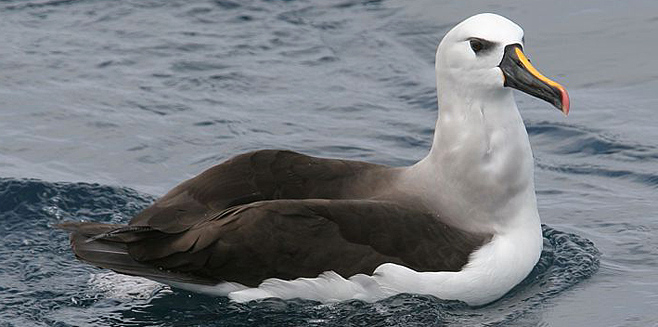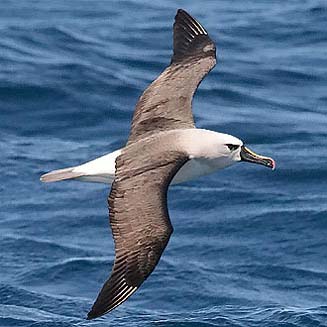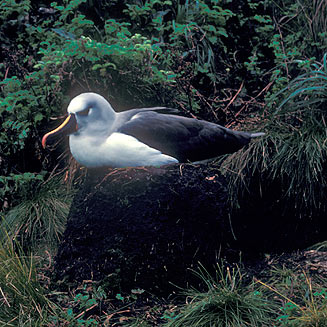|
Thalassarche chlororhynchos
(Atlantic yellow-nosed albatross, Yellow-nosed albatross)
[= Diomedea chlororhynchos]
Atlantiese Geelneusalbatros [Afrikaans]; Geelneusmalmok
[Afrikaans]; Geelbekalbatros [Dutch]; Albatros à nez jaune [French];
Gelbnasenalbatroß [German]; Albatroz-de-bico-amarelo [Portuguese]
Life
> Eukaryotes >
Opisthokonta
> Metazoa (animals) >
Bilateria >
Deuterostomia > Chordata >
Craniata > Vertebrata (vertebrates) > Gnathostomata (jawed
vertebrates) > Teleostomi (teleost fish) > Osteichthyes (bony fish) > Class:
Sarcopterygii (lobe-finned
fish) > Stegocephalia (terrestrial
vertebrates) > Tetrapoda
(four-legged vertebrates) > Reptiliomorpha > Amniota >
Reptilia (reptiles) >
Romeriida > Diapsida > Archosauromorpha > Archosauria >
Dinosauria
(dinosaurs) > Saurischia > Theropoda (bipedal predatory dinosaurs) >
Coelurosauria > Maniraptora > Aves
(birds) > Order: Ciconiiformes
> Family: Diomedeidae
 |
|
Atlantic yellow-nosed albatross, offshore from Cape
Town, South Africa. [photo Trevor Hardaker ©] |
 |
 |
|
Atlantic yellow-nosed albatross. [photo
Jeff Poklen
©] |
Atlantic yellow-nosed albatross on nest (taken
outside of southern Africa). [photo
Peter Steyn
©] |
Distribution and habitat
Breeds on Tristan da Cunha and Gough Island, dispersing
across the South Atlantic and South-West Indian oceans, including southern
African waters. Here it is fairly common in the cold water off the west coast of
South Africa and Namibia, while more scarce south of the Western and Eastern
Cape.
Movements and migrations
Adults arrive at their breeding colonies in
late August, with the chicks fledging from mid March-April and
rapidly dispersing soon afterwards. It is present year-round in
southern African waters, with a peak numbers in winter, especially
from May-June off Namibia. Adults may reach southern Africa when
they are incubating the eggs and raising chicks, as then they go on
extremely lengthy foraging trips
Food
It mainly eats pelagic schooling fish, crustaceans and
squid; it is much less dependent on fishery bycatch and offal than many other
albatrosses. It does most of its foraging by catching prey on the surface of the
water, occasionally plunge-diving to greater depths. The following food items have been recorded
in its diet:
- fish
- Scomberesox saurus (Saury)
- Etrumeus whiteheadi (Round herring)
- Engraulis encrasicolus (Anchovy)
- Sardinops sagax (Sardine)
- Trachurus trachurus (Horse mackerel)
- squid
- crustaceans
Threats
Its status it has recently changed from Near-threatened
to Endangered, largely due to decreasing population its colonies at
Gough Island and Tristan da Cunha, probably caused by mortalities on longlines.
References
-
Hockey PAR, Dean WRJ and Ryan PG 2005. Roberts
- Birds of southern Africa, VIIth ed. The Trustees of the John Voelcker
Bird Book Fund, Cape Town.
|
